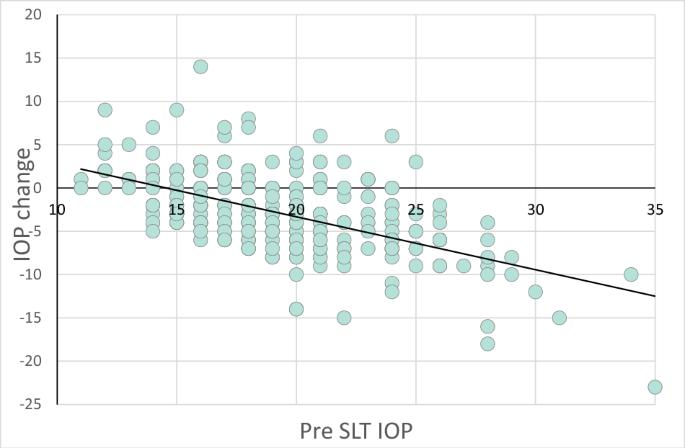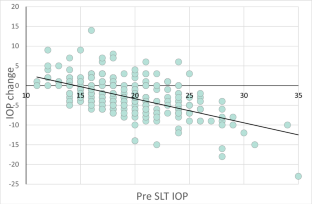英国兰开夏教学医院选择性激光小梁成形术疗效回顾。
IF 3.2
3区 医学
Q1 OPHTHALMOLOGY
引用次数: 0
摘要
导言:过去七年来,兰开夏教学医院一直在开展选择性激光小梁成形术。这项工作旨在对该医院使用选择性激光小梁成形术的情况进行回顾。主要目的是确定选择性激光小梁成形术在降低眼压方面的疗效,分析之前使用不同外用药物治疗如何影响选择性激光小梁成形术的疗效,以及分析复明患者的疗效:我们对2018年10月至2020年1月期间接受初次SLT激光治疗的288只已知有青光眼或眼压过高病史的眼睛进行了回顾性审查。SLT适用于已知青光眼患者和眼压控制不理想的治疗新手。所有患者数据均完全匿名:我们发现,SLT 能有效降低眼压。约三分之二的患者(181/280,65%)的眼压降低了 10% 或更多。略低于一半的眼球(127/280,45%)降低了 20% 或更多。我们发现,如果 SLT 前的眼压为 14.6 mmHg,预计眼压不会发生平均变化,而 SLT 前的眼压每超过这一阈值 1 mmHg,预计眼压的平均降幅为 0.61 mmHg。我们还发现,与单用 PGA 相比,PGA 加眼压抑制剂的联合疗法能带来更好的疗效。我们发现,复明 SLT 与首次治疗相比效果更佳,但首次治疗效果并不能很好地预测复明 SLT 的成功率:结论:在这项研究中,初治和复治 SLT 对所有患者均有效。本文章由计算机程序翻译,如有差异,请以英文原文为准。


A retrospective review of selective laser trabeculoplasty outcomes at Lancashire Teaching Hospitals, UK
Selective laser trabeculoplasty has been carried out at Lancashire Teaching Hospitals over the past seven years. This work aimed to review the use of SLT in this Trust. The primary objectives were to establish the efficacy of SLT in reducing intraocular pressure, to analyse how prior treatment with different topical medications can influence SLT outcomes and to analyse the outcomes in revisionary patients. We conducted a retrospective review of 288 eyes, with a known history of glaucoma or ocular hypertension and who underwent initial SLT laser treatment between October 2018 and January 2020. SLT was performed on known glaucoma and treatment naïve patients where IOP control was deemed sub-optimal. All patient data was fully anonymised. We found that SLT was effective in lowering IOP. Around two-thirds of the eyes (181/280, 65%) achieved a reduction in IOP of 10% or more. Just under half (127/280, 45%) achieved a reduction of 20% or more. For a pre-SLT IOP of 14.6 mmHg, we found that no mean change in IOP is expected, and for each 1 mmHg by which the pre-SLT IOP exceeds this threshold, the mean reduction in IOP is expected to be 0.61 mmHg. We also found that combination therapies of PGA plus aqueous suppressants gave better outcomes compared with PGA alone. We found that revisionary SLT compared favourably with the first treatment, although first-time outcomes were not a good predictor of success with revisionary SLT. Primary and revisionary SLT has been shown to be effective across the cohort of patients in this study.
求助全文
通过发布文献求助,成功后即可免费获取论文全文。
去求助
来源期刊

Eye
医学-眼科学
CiteScore
6.40
自引率
5.10%
发文量
481
审稿时长
3-6 weeks
期刊介绍:
Eye seeks to provide the international practising ophthalmologist with high quality articles, of academic rigour, on the latest global clinical and laboratory based research. Its core aim is to advance the science and practice of ophthalmology with the latest clinical- and scientific-based research. Whilst principally aimed at the practising clinician, the journal contains material of interest to a wider readership including optometrists, orthoptists, other health care professionals and research workers in all aspects of the field of visual science worldwide. Eye is the official journal of The Royal College of Ophthalmologists.
Eye encourages the submission of original articles covering all aspects of ophthalmology including: external eye disease; oculo-plastic surgery; orbital and lacrimal disease; ocular surface and corneal disorders; paediatric ophthalmology and strabismus; glaucoma; medical and surgical retina; neuro-ophthalmology; cataract and refractive surgery; ocular oncology; ophthalmic pathology; ophthalmic genetics.
 求助内容:
求助内容: 应助结果提醒方式:
应助结果提醒方式:


